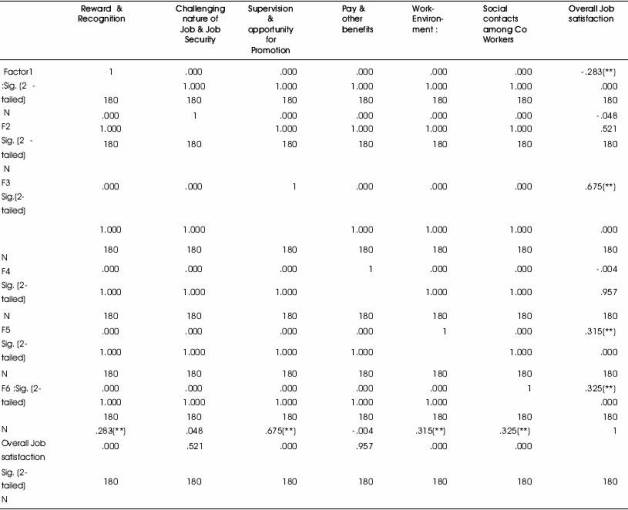- Bimal Jalan, former Governor, Reserve Bank of India - speech delivered at the Banking Economist Conference, at the Kolkata on 14 Jan, 2010.
Introduction
Banks play a crucial role in the financial system of a country and an efficient, enduring and profitable banking system is a pre-requisite for the development of the economy. With opening of the financial sector, there is rapid transformation in the Indian banking industry. Banks are expanding and diversifying their activities beyond the boundaries of traditional banking and there is intense competition among them to increase their business and expand customer base by offering innovative products.
With entire banking focus now moving towards attracting customers, introducing new products, increasing profitability, the policy makers in banks are now putting emphasis on job satisfaction of their employees.
In any organization, human resources form the backbone and their satisfaction with the job is essential for the sustained growth and success of the organization. Satisfied employees are inclined to be more industrious, inspired and dedicated to their work, Syptak et al. (1999).
Psychologists and researchers have long been interested in finding out the co-relation between job satisfaction and functioning of employees. Low rate of job satisfaction of employees results in lower performance of the organization Kaya, 1995. The success, survival and competing power of an organization depends upon the commitment of its employees.
Job satisfaction is an effective reaction to an individual's work situation and has been defined as a positive feeling about one's job based on one's evaluation of the characteristics of the job Robbins & Judge, 2007. It can be described as a positive emotional state that results from the evaluation of the experiences given by the job Locke, 1976. However, as per Taylor(1911), salary plays an important role in influencing the attitude of employees and they will be satisfied with the work if they get higher economic benefit from it. But Taylor's solely monetary approach has been changed with passage of time and job satisfaction is now more attributed to complex humanistic approach.
There is so much of churning in the market place that anticipating the future is the biggest challenge. The hire and fire style of management that is so relevant today that the term job satisfaction loses its content, pervasiveness, psychological purport and meaning. Job-hopping is the order of the day, the boss changes, the work environment changes, the job-content changes and with that the interpersonal relationship. As per Olulube(2006), in the present era of globalization, economic reforms and technology revolution, job satisfaction is an elusive term.
Post nationalization, in 70s and 80s, banks were the preferred destination for majority of the educated youth. They were attracted towards banking profession because of both extrinsic and intrinsic factors. Banks not only offered good salary but also provided opportunities for career advancement (extrinsic factors). At the same time the job was challenging, offered variety and opportunity for social service and bankers enjoyed recognition in the society (intrinsic factors). While both extrinsic and intrinsic forces motivated people to take banking as a career during 1970 to 1990, it was the extrinsic conditions that influenced their job satisfaction and their desire to continue in banks. But after 1991, the banking scenario has been changed completely. The impact of globalization, economic reforms, technology adoption and competition from new players have affected work culture in the banks. Banks are witnessing a fundamental shift in working attitude & work style of the employees Bajpai, Naval & Srivastava Deepak,2004.
1. Literature Review
Various theories have been developed to explain the factors responsible for the job satisfaction of the employees in an organization. At the same time researchers have attempted to identify the components of job satisfaction, measure the relative importance of each components of job satisfaction and examined what effects these components have on employees' productivity Sowmya and Panchanatham, 2011.
Study of the literature reflects that the concept of job satisfaction got highlighted by Hoppock (1935). He reviewed various studies conducted on job satisfaction prior to 1933 and observed that job satisfaction is a combination of three things, (1) psychological, (2) physiological & (3) environmental circumstances that cause a person to stay in a job.
Herzberg (1959) studied the factors influencing job satisfaction level of 203 workers in and around Pittsburg, USA and observed that two separate sets of conditions are responsible for the motivation or dissatisfaction of the employees. When one set of conditions (he referred it as 'motivator') is present in an organization, workers of that organization feel motivated but its absence does not dissatisfy them. When another set of conditions (he called it as 'hygiene factors') is absent in the organization, the workers feel dissatisfied, but its presence does not motivate them. The two sets are unidirectional, that is, their effect can be seen in one direction only. According to him : Achievement, Recognition, Advancement, The work, Possibility of Growth & Responsibility are factors of motivation. Whereas, Company policy and administration, Technical supervision, Interpersonal relations with superiors, peers and subordinates, Salary, Job security, Personal life, Work conditions & Status are Hygiene factors, the factors that remove pain from environment. They are known as job-environment factors. Motivators are factors which result in psychological growth. These are job-centered and are known as jobcontent factors. In pleasant situations motivators appear more frequently than hygiene factors while their predominance is reversed in unpleasant situations.
Smith et al.,(1969), found that the situational characteristics like, the work itself, pay, promotion, supervision and co-workers, are the key factors in job satisfaction, although other variables such as employee involvement and organizational commitment might also impact the employees.
Abdel-Halim(1983) in his study of 229 supervisory and nonsupervisory employees in a large retail-drug company concluded that individuals who have high need-forindependence performed better and were more satisfied with high participation for non-repetitive tasks. A study by Knoop(1991) showed that a participative management style was mostly preferred by today's managers to increase their employees' job satisfaction. Carr and Kazanowsky (1994) found that that inadequate salary was much related to employees' dissatisfaction.
Howand and Frink(1996) in their study found that managerial employees(Officers) were more satisfied with their job than their non-managerial counterparts, since being managerial employee, they indirectly enjoy increased job satisfaction with supervision, workmotivation, life-satisfaction and also with co-workers.
Consequently, numerous researches have been going on job satisfaction for many years. However, job satisfaction of the bank officers assumes utmost importance since banks play a crucial role in the economic development of a country. A satisfied bank officer is the corner stone of a successful banking system.
Bhatt (1998) found that job satisfaction is the result of effect of so many factors and the level of satisfaction differs from time to time and also depends on situation. The attitude of an employee affects a lot and one gets satisfaction in any of the activities depending upon how he/she perceives the situation and what is expected in exchange of effort. His survey on the level of job satisfaction of bank employees in the state of Gujarat indicates that though supervisors are having little differences with management policies on certain issues(e.g. social banking policies as directed by the Govt of India), they are overally satisfied, while clerks who have to face public are little bit stressed. He also found that with computerization, repetitive tasks of clerical staff have been reduced and it has increased their satisfaction level.
Huang(1999) studied the factor affecting the Job satisfaction of employees in Taiwan and found that challenging nature of job, reward, opportunity for promotion, working condition, supportive colleagues are the factors that affect the job satisfaction of employees.
Durkins and Bennet (1999) in their study on the level of commitment of bank employees in the retail banking sector in United Kingdom found that bank employees demonstrate low level of work commitment and inability to embrace change initiatives.
Islam and Saha (2001) evaluated job satisfaction of bank officers in Bangladesh and identified the relative importance of job satisfaction factors and their impacts on the overall job satisfaction of officers. The result showed that salary, efficiency in work, fringe benefits, supervision, and co-worker relation are the most important factors contributing to job satisfaction. Private bank officers have higher levels of job satisfaction than those from public sectors as they enjoy better facilities and supportive work environment. Work experience is found as the second most important factor affecting job satisfaction. Sex and age differences have relatively lower level of impact on it. The overall job satisfaction of the bank officers was found to be positive.
According to the study conducted by Opkara(2002), factors like pay, the work itself, supervision, co-workers, opportunity for promotion are the main factors contribute to the job satisfaction of the employees.
Bajpai, Naval & Srivastava Deepak (2004) conducted a study on the degree of job satisfaction among public and private sector bank employees in India by randomly selecting 25 employees from each bank (two public sector and two private sector banks). He observed that there was significant difference among public and private banks. The result indicated that layoff threats, quick turnover, less welfare schemes, and less scope for vertical growth decrease job dissatisfaction. On the other hand, secure job environment, welfare policies, and job stability increase the degree of job satisfaction. His study indicated that the degree of job satisfaction among private sector bank employees was significantly lower than that of the public sector bank employees. Employees of private sector banks perceive that their jobs are not secure and the environment is highly competitive. Job security is based on performance and therefore, the employees feel insecure, resulting in reduction in overall job satisfaction. In public sector banks, welfare policies are clearly defined and retirement policies are effectively executed. So there is no problem with job security and thus their job satisfaction level is higher as compared to private sector banks.
Thakur (2007) made an effort to study the job satisfaction level among employees of selected private and public sector banks in Ludhiana. Bank jobs have always remained the first preference of the youth here. So, this study is also an effort to find out what they think of this job afterwards. Kaur (2007) examined the job satisfaction level of 297 bank employees of two public sector banks in India after organizational change initiative. The findings of her study reveal that employees are generally satisfied with their jobs after such changes.
Kamal and Sengupta(2008) found that with the change of satisfaction determinants, level of job satisfaction also varies. As person ages, his job satisfaction shows an increasing trend. With age, spiritualism of the person increases, but his alternatives for change decreases. Younger employees have more energy, more expectations and more options, and hence have lesser satisfaction with the job. Overally, the job satisfaction of bank officers though not very high, still they are satisfied and there is room for improvements.
Desa, Nasina Mat (2010) conducted a study on leadership behaviour and Job satisfaction among bank officers. The study finds that a good understanding between managers and subordinates will enhance teamwork and organizational performance. Employees are most strongly motivated when the demands made on them fit their individual and cultural values. Those who are in a position to lead are expected to preserve the revered values of the workforce and cascade them downwards personally. Leaders and managers have to say and do, i.e. they have to “walk the talk” .
Sowmya and Panchanatham(2011) conducted a study on factors affecting the job satisfaction of employees in the banks of Chennai, India. They found that pay, promotion, organizational aspects, supervision, job itself, working condition, co-workers' behavior are the main factors of job satisfaction of bank employees.
Review of the literature shows that various factors affect the job satisfaction of bank employees. But there is limited study to explain the impact of the changes in the banking and financial sector, since the late 90s, after the economic reforms, deregulation, technological innovation, etc. on the job satisfaction of bank officers. This gap in the literature has motivated the author to find out the determinants of job satisfaction of officers in the banking sector in India, in the post reforms era. This study will help the future researchers to conduct further studies in this regard.
2. Objectives
- To investigate the factors that determines the level of job satisfaction among officers of the bank.
- To analyze the relationship between these factors of job satisfaction with overall job satisfaction level.
- To suggest steps to be taken for improvement in job satisfaction among officer.
3. The Research Methodology
The study is an evaluative and diagnostic attempt to find out analytically the factors determining job satisfaction among bank officers in public sector banks after economic reforms in the early 1990s.
3.1 Sampling
For the purpose of this study, officers of two public sector banks, viz. State Bank of India and Syndicate Bank were selected from Cuttack and Bhubaneswar, the twin cities of Odisha. A sample of 180 officers was selected using convenience sampling technique. The responses given by the officers were anonymous and confidential. All analyses described below are based on the data from these 180 subjects.
3.2 Instrumentation Design
For this purpose of study, a well-structured questionnaire was framed basing on Minnesota Satisfaction Questionnaire (short form developed in 1977) and modified with the help of a research expert to make it suitable for the target group (bank officers). The Minnesota Satisfaction Questionnaire (MSQ) is designed to measure employees' satisfaction with their particular jobs and makes it feasible to obtain an individualized picture of worker's job satisfaction as well as providing an accurate measurement of job satisfaction for groups of individuals on numerous workplace factors.
The questionnaire was personally administered to the selected sample respondents. Respondents were asked to rate each statement on a 5-point scale (5 to 1), varying from '5' as “Strongly Agree” (5 point) to '1' as “Strongly Disagree” (1 point). The middle points are '4' as Agree, '3' as can't say, and '2' as Disagree. The part of the questionnaire pertaining to demographic survey is composed of 4 variables viz: gender, age, qualification and income.
3.3 Data Collection
The data for the purpose of the study were collected from primary sources. Structured questionnaires were designed to gather information from the sample respondents covering various aspects of job satisfaction by personally meeting the officers at their work places/ residences and through telephonic interview. Before finalizing the questionnaire (ref Annexure-I), pre-testing of the questionnaire was carried out for the qualitative investigation for which 30 samples (about 15 percent of the sample) were administered. The bank officers were personally briefed about the purpose of the study and all questions were clarified.
3.4 Limitations of the Study
- Due to fear or confidentiality reasons, information might not have been accurately revealed by some of the respondents as desired by the researcher.
- Some of the replies given by the respondents might be biased due to their personal liking or disliking.
- Since environment and needs of the people are rapidly changing, the findings of the study may become irrelevant over a period of time.
- The study was limited to the geographic boundaries of the state of Odisha and due to paucity of time, it was confined to a relatively small sample. Hence the findings of the study based on a small sample size could not be generalized; thus limiting its application to the organizations covered under the study.
4. Results
4.1. Demographic Statistics
Table 1 indicates that out of the total of 180 respondents, 132 were males, i.e. as many as 73.3%, whereas women officers constituted only 48, i.e. around 26.7%. Young group( up to 35 years) constituted 42.2% out of which up to 25 years (youngest group ) was close to 16%. The middle age group (36 years to 45 years) was 18 % where as old group (46 years and above) was 40 % which included 12.2% above 55 years of age being the oldest group. 55.56% of the respondents were highly educated (PG/MBA/MCA) and 44.44% were graduates. The results showed 60% of the respondents had family income above Rs. 30,000/- per month. Figure-1 describes the demographic variable graphically.

Figure 1. Demographic variables.
4.2 Factor Analysis
Factor analysis was carried out through SPSS (Ver.13) to simplify the data. The analysis was carried out through principal component analysis along with orthogonal rotation procedure of varimax for summarizing the original data items with minimum factors and optimal coverage. Entries of factor loadings less than 0.5 and Eigen values less than 1.0 were ignored (ref Annexure-II).
4.2.1 Reliability and Validity
The reliability of the data collected was judged through different tests including ANOVA and Cronbach Alpha. The values for Kaiser- Meyer-Olkin Measure (KMO) and Bartlett's Test, and Cornbach's Alpha are shown in Table 2. The alpha value was found to be 0.897 which indicated that all the factors in the study had adequate reliability. The Kaiser-Meyer-Olkin (KMO) method of sampling adequacy shows KMO coefficient (.661) more than 0.5 which implies factor analysis for data reduction is effective. The significance is .000 is less than the assumed value which signifies the validity of factor analysis.
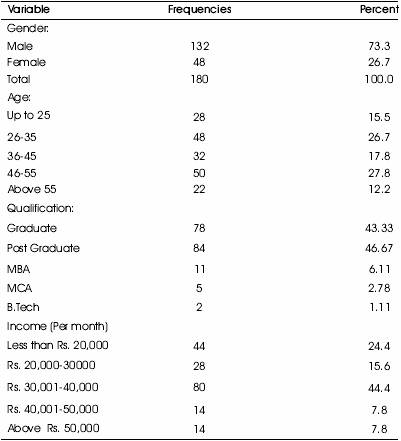
Table 1. Demographic Statistics of the Respondents

Table 2. KMO and Bartlett's Test, Cornbach's Alpha.
4.2.2 Results of Factor Analysis
Factor analysis was used to understand the important factors influencing the job satisfaction among officers. 20 variables were taken into consideration for research. The process of factor analysis resulted in six factors with different levels of variance accounting for 84.273% of the total variance. So the number of variables economized from 20 to only 6, thus loosing only 15.727% of the information. The extracted factors were: Reward &Recognition, Challenging nature of Job & Job Security, Supervision & Opportunity for Promotion, Pay and Other benefits, Work Environment and Co-Workers. Eigen values, percentage of co-variance are presented in Table - 3 and the results of the rotated factor matrix have been depicted in Table 4. The relationship between the independent variables and dependent variables is shown in Figure 2.
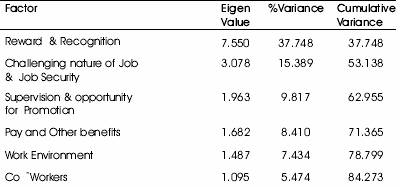
Table 3. Eigen Value, % Variance & Cumulative Variance.
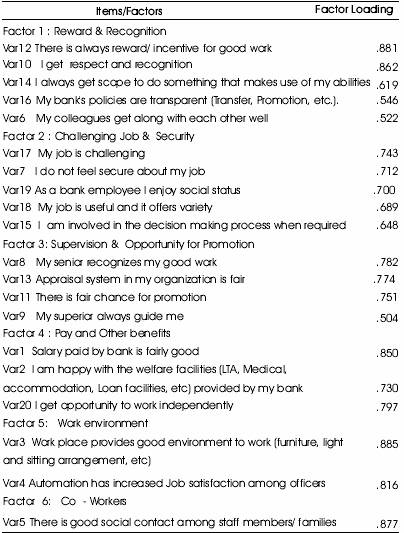
Table 4. Factor Loading.

Figure 2. Factors of Job satisfaction & Overall Job satisfaction.
4.2.3 Factor 1 : Reward & Recognition
This is the most important factor which accounts for close to 38% of the total variance. The table shows the composition of this factor. In all five variables are loaded in this factor. Reward and recognition (.881) for good work encourages the officers to do more and do better. Officers expect that they should get opportunities to show their abilities in work (.619). They also expect that the organization should have transparent policies towards transfers, promotions (0.546), etc. Further, having friendly and helpful co-workers is a modest source of job satisfaction (.522).
4.2.4 Factor 2 : Challenging nature of Job & Job Security
Challenging nature of the Job and Job security is the second most important factor as per the analysis of data. It accounts for 15.389% of the total variance. Five variables are loaded in this factor. It is said monotony mars the mirth. One can do better if he is jolly at his work. People in the organization expect that their job should be challenging (.743) and it should offer variety (.689). Security of Job is very vital for the officers (.712). To the officers a job is not only a source of income it also represents self-esteem, social status i.e. a place in the society. The officers expect that their job should get them social status (.700). Similarly officers expect that they should be given opportunities to participate in the decision making process (.648).
4.2.5 Factor 3 : Supervision and opportunity for Promotion
The third important factor that influences job satisfaction is 'Supervision and opportunity for Promotion'. It accounts for 9.817% of the total variance: This factor shows the relationship of the officers with their superiors. Officers expect that their immediate superiors should recognize the good work done (.782) and appraise their performance appropriately. Correct assessment of their performance motivates the officers (.774). Similarly promotion is an important factor (.751) for the officers and this brings them job satisfaction.

Table 6. ANOVA for Regression.
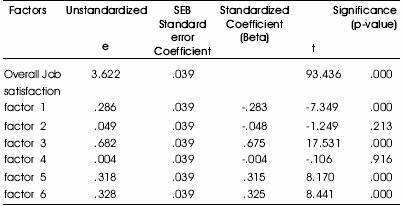
Table 7. Regression- Coefficients.
4.2.6 Factor 4 : Pay and other benefits
Pay or Salary is the fourth important factor that influences the job satisfaction of the officers. It accounts for 8.410% of the total variance. It plays a significant role in determining job satisfaction of officers (.850). Salary includes allowances like house rent allowance, city compensator y allowance, dearness allowance, qualification/ professional qualification allowance. Other benefits like leave travel concession, petrol/conveyance allowance, lunch and entertainment allowance, payment or compensation for working on holidays or late sitting allowance, medical and hospitalization benefits, festival allowance, availability of easy and low interest loans, etc. influence significantly in job satisfaction of officers (.730). If officer feels that he is underpaid it will negatively affect his job satisfaction. People also like to work independently and this is a very vital factor which influences the job satisfaction among officers(.797).
4.2.7 Factor 5 : Work Environment
Work environment plays a significant role in determining the job satisfaction among officers. It is the fifth important factor and accounts for 7.434% of the total variance. Two variables are loaded in this factor The general working condition like having good sitting arrangements,adequate light, furniture, etc. at the work place influences the job satisfaction of the officers (.885) to a large extent. Officers feel motivated when automated / computerized environment is provided at the work place (.816).
4.2.8 Factor 6: Social contacts among Co-Workers
This is the sixth factor which accounts for 5.474% of the total variance. Officers expect that their job should provide opportunities to maintain good social contacts among co-workers and this factor has a good influence on the job satisfaction of the officers (.877).
4.3 Pearson's Correlation Coefficient
Table 5 describes results of the Pearson's coefficient among variables. It reveals that the overall job satisfaction, i.e. the dependent variable is significantly correlated to Factor 3 (Supervision and opportunity for Promotion, r =.675**), Factor 4 ( Work-Environment, r =.315**), Factor 6 (Social contacts among Co-Workers, r =.325** , Factor1 (Reward & Recognition, r = -.283**) and Factor 2 (Challenging nature of Job & Job Security, r = -.048).
4.4 Multiple Regression Analysis
Multiple Regression analysis depicts the extent and direction of relationship between the dependent variable and the independent variables. Table 6 shows that overall regression model is significant (F = 83.488, p < .000, Rsquare =0.743). Analysis of variance (ANOVA) assesses the overall significance of the model. The result shows that p-value is < .000 (zero to three decimal places). Therefore, the model is statistically significant and job satisfaction factors are significantly related to overall job satisfaction of the officers. The coefficient of multiple regressions, R square is 0.743 which indicates that 74% of the job satisfaction is explained by the six factors. Thus, the regression equation is useful in making predictions. Adjusted R-square gives idea of how well our model is generalized. When value of R square and adjusted R square are same or very close the model can be treated as generalized. Our result shows that R-square – Adjusted R-square are very close. (R-square – Adjusted R-square 0.743 - 0.734 = .009 or 0.9%). This shrinkage shows that if the model were derived from the population rather than the sample, it would account for approximately 0.9 % less variance in the outcome.
Table 7 displays the values of the coefficients in the regression equation and measures the probability that a linear relationship exists between each predictor and dependent variable. In this model the variables Reward & Recognition, Supervision and Opportunity for Promotion, Work environment and Social contacts among co-workers have significant values. Thus there is a significance linear relationship between overall job satisfaction and Reward & Recognition, Supervision and Opportunity for Promotion, Work environment and Social contacts among co workers.
Conclusion and Recommendations
The study focused on the factors affecting job satisfaction of officers in public sector banks. Previous researchers have found that job satisfaction of bank employees (officers) is influenced by pay, promotion, supervision, relationship with co-workers, work environment (Islam and Saha, 2001, Sowmya and Panchanatham, 2011). The findings of the current study show that the job satisfaction of bank officers is mainly influenced by reward & recognition, supervision, opportunity for promotion, work environment and social contacts among co-workers. Other factors like pay, job security, social status, etc. are found to be less significant.
A satisfied bank officer is always committed to high quality performance, increased productivity and he (or she) adds value to the organization. In the post reforms era, bank managements should seriously analyze the factors affecting the job satisfaction of their officers and take serious steps to reduce the grievances, bad feelings, absenteeism of their officers and at the same time improve their morale.
If we look back to 1970s through 1990s, we would find, public sector banks were regarded as good employers. People preferred banking as a career as banks not only offered relatively good salary but also rewarded performance of the officers and provided good opportunities for career growth, which influenced their satisfaction with the job. But during the 90's, public sector banks slowly lost their status as good employers, their performance was threatened with the arrival of new generation banks. These new generation banks offered better opportunities for career growth, recognized and rewarded the officers basing on their performance, offered better salary and provided good working environment. The PSBs failed in both. In one hand they failed in offering matching compensation, on the other hand, they lacked in providing proper conducive atmosphere for influencing the job satisfaction of the officers.
The winds of liberalization, globalization, economic reforms and innovation in technology have brought fresh air and there is increased demand from the customers for better service, newer products and speed. There is no end to the demand of the customers. Creating competitive edge to overcome the challenge forced by the new generation tech savvy banks, have led the officers to talk about work culture and there is realization of the management to improve the same.
Recommendations
- Reward and recognition motivates the officers. Banks should encourage competitive work culture at the work place and ensure that due recognition / reward / compensation is given to the deserving officers based on their performance. Reward and recognition goes a long way in influencing the job satisfaction of the officers.
- One of the factors responsible for job satisfaction among employees is their immediate supervisor. Supervisors/ seniors should be trained how to guide and influence the job satisfaction of their subordinate officers. They should not hesitate to recognize the good work done by the junior officers and make fair, objective and unbiased appraisal of their performances. They should regularly guide them in their works.
- Management should take care to see that all the officers get promotional opportunities in the organization. Promotion process should be transparent and fair. When a deserving candidate does not get promotion where as a less deserving candidate gets promoted, it spreads frustration and officers lose faith in the system and promotion process. Similarly when seniors are neglected and juniors are promoted it also leads to demotivation and frustration. The management should ensure that fair and just promotion process is in place.
- Management should ensure that all policies / rules concerning the officers are transparent. There should not be any scope for favoritism, nepotism or subjective assessment. Officers should feel that they are given fair chance and there is no room to feel discriminated or overlooked or neglected.
- Poor working conditions can erode an officer's initiative and enthusiasm and can lead to absenteeism and enthusiasm and can lead to absenteeism and turnover.
